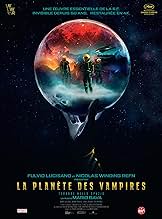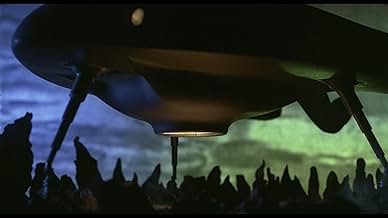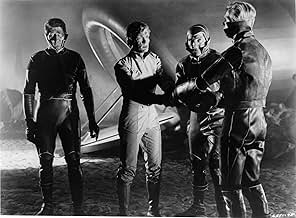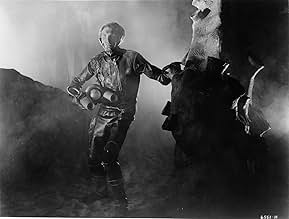IMDb RATING
6.2/10
7.7K
YOUR RATING
After landing on a mysterious planet, a team of astronauts begin to turn on each other, swayed by the uncertain influence of the planet and its strange inhabitants.After landing on a mysterious planet, a team of astronauts begin to turn on each other, swayed by the uncertain influence of the planet and its strange inhabitants.After landing on a mysterious planet, a team of astronauts begin to turn on each other, swayed by the uncertain influence of the planet and its strange inhabitants.
- Awards
- 1 nomination total
Ángel Aranda
- Wess Wescant
- (as Angel Aranda)
Federico Boido
- Keir
- (as Rico Boido)
Vito Fasano
- Dead Galliott Crew Member
- (uncredited)
Giuseppe Mattei
- Brent
- (uncredited)
Featured reviews
This new release in the "MGM Midnight Movies" series of DVDs is an absolute must-have. The print of this 1965 classic is gorgeous, and for the first time since its theatrical release viewers can see the film in its original wide-screen format. For those who -- like me -- purchased the HBO Video version on VHS, don't worry: The original spare-but-effective electronic score has been restored, instead of the "updated" abomination that made the VHS print almost unwatchable.
Although I've never heard Dan O'Bannon acknowledge it, certain elements of this film must have been in his mind when he was working on "Alien": Two spaceships are drawn to an eerie, fog-shrouded planet by a mysterious radio signal, then snatched from orbit by an irresistible force. After crash landing, the surviving crew find themselves pitted against their own dead shipmates, resurrected by the parasitic mentalities of the planet, a dying race who must find a new home. There's even a scene where Barry Sullivan and Norma Bengell investigate an ancient, derelict alien spacecraft, complete with giant skeletons (any of this sound familiar?)
The set designs -- the cavernous interior of the spaceship and the appropriately alien fixtures of the derelict -- are some of the best you'll find in any pre-1968 science fiction film. Sullivan is suitably stoic as the warrior-scientist Captain; the supporting cast and in particular the luscious Ms. Bengell turn in remarkably understated performances, perfectly conveying dread verging on panic. While this movie may disappoint fans of director Mario Bava who are more familiar with his horror films, as a science fiction film buff I rate it a solid 7.
Although I've never heard Dan O'Bannon acknowledge it, certain elements of this film must have been in his mind when he was working on "Alien": Two spaceships are drawn to an eerie, fog-shrouded planet by a mysterious radio signal, then snatched from orbit by an irresistible force. After crash landing, the surviving crew find themselves pitted against their own dead shipmates, resurrected by the parasitic mentalities of the planet, a dying race who must find a new home. There's even a scene where Barry Sullivan and Norma Bengell investigate an ancient, derelict alien spacecraft, complete with giant skeletons (any of this sound familiar?)
The set designs -- the cavernous interior of the spaceship and the appropriately alien fixtures of the derelict -- are some of the best you'll find in any pre-1968 science fiction film. Sullivan is suitably stoic as the warrior-scientist Captain; the supporting cast and in particular the luscious Ms. Bengell turn in remarkably understated performances, perfectly conveying dread verging on panic. While this movie may disappoint fans of director Mario Bava who are more familiar with his horror films, as a science fiction film buff I rate it a solid 7.
Mario Bava's Planet of the Vampires is one of the films credited as being a major influence on Ridley Scott's Alien (1979), and it's easy to see why: there are numerous scenes and elements that are very similar to those in Scott's movie (albeit with a distinct '60s Euro sci-fi flavour). Bava's movie isn't on a par with Alien in terms of overall quality-the movie suffers a little from its low budget and it treads water for a long while-but its sense of style and originality still makes it a lot of fun for those who enjoy retro sci-fi/horror.
The film starts as the crew of the spaceship Argos (a horseshoe shaped craft, much like the alien spaceship in Alien) approach the planet Aura having receiving a strange transmission (as in Alien). They land on the foggy surface of the planet (as in Alien) and are immediately gripped by a compulsion to attack each other. After this spate of craziness passes, the crew walk to their sister ship, the Galliot, which also landed on the planet, and find the crew dead. Further investigation of the surrounding area reveals the wreck of an alien ship (as in Alien) where they discover the giant skeletons of its extraterrestrial crew (as in Alien). Eventually, it transpires that the space signal intercepted by the Argos was sent by a dying race that seeks to inhabit any visitors unfortunate to land on their planet (parasitic creatures - Alien anyone?).
For all of their similarities, Bava's film couldn't be much more different to Alien in terms of style: whereas Scott's film aimed for a gritty sense of realism, Bava's is much more rooted in pulp sci-fi comics, with the strangely spacious spaceship Argus, its crew's snazzy uniforms (the collars and hoods are hilarious), lots of high tech equipment with flashing diodes, a bright colour palette, and strong use of light and shadow. The film also predates George Romero's Night of the Living Dead with the reanimated crew of the Galliot more akin to modern day zombies than vampires.
After quite a bit of filler, the surviving members of the Argus finally escape Aura, the film ending with a twist worthy of an episode of Rod Serling's The Twilight Zone.
6.5 out of 10, rounded up to 7 for the tasty female crew members of the Argus, sexy redhead Sanya (Norma Bengell) and blonde hottie Tiona (Evi Marandi).
The film starts as the crew of the spaceship Argos (a horseshoe shaped craft, much like the alien spaceship in Alien) approach the planet Aura having receiving a strange transmission (as in Alien). They land on the foggy surface of the planet (as in Alien) and are immediately gripped by a compulsion to attack each other. After this spate of craziness passes, the crew walk to their sister ship, the Galliot, which also landed on the planet, and find the crew dead. Further investigation of the surrounding area reveals the wreck of an alien ship (as in Alien) where they discover the giant skeletons of its extraterrestrial crew (as in Alien). Eventually, it transpires that the space signal intercepted by the Argos was sent by a dying race that seeks to inhabit any visitors unfortunate to land on their planet (parasitic creatures - Alien anyone?).
For all of their similarities, Bava's film couldn't be much more different to Alien in terms of style: whereas Scott's film aimed for a gritty sense of realism, Bava's is much more rooted in pulp sci-fi comics, with the strangely spacious spaceship Argus, its crew's snazzy uniforms (the collars and hoods are hilarious), lots of high tech equipment with flashing diodes, a bright colour palette, and strong use of light and shadow. The film also predates George Romero's Night of the Living Dead with the reanimated crew of the Galliot more akin to modern day zombies than vampires.
After quite a bit of filler, the surviving members of the Argus finally escape Aura, the film ending with a twist worthy of an episode of Rod Serling's The Twilight Zone.
6.5 out of 10, rounded up to 7 for the tasty female crew members of the Argus, sexy redhead Sanya (Norma Bengell) and blonde hottie Tiona (Evi Marandi).
I saw this film in it's 1965 American release, and at the time I was not overly impressed. It was obviously made on a low budget, the dialog dubbing is bad (although far superior to some other Italian imports I have seen), the acting alternates between wooden (Barry Sullivan) and outrageously overdone (i.e., "gravity effects", the reaction of the actor who smashes the "meteor deflector", numerous fear reaction shots of crew members). Time has proven that it has become a trend setter for numerous subsequent sci-fi films (most notably Ridley Scott's "Alien" (1979)). I recently viewed it again 37 years after it's release, and the similarities to "Alien" are unmistakable. The attentions of the crews of both films are attracted by mysterious radio signals originating from an unexplored world. The horseshoe shape of the ships in POTV resembles that of the wrecked alien spacecraft in "Alien". There are similar shots of the ship's landing gear in both films. Both crews find ancient wrecked spacecraft and skeletal remains of giant aliens on the planets they land upon. There is an unknown predatory alien presence in both films. Lots of gore footage exists in both films too, although POTV unarguably started this trend (alas, is there any recent sci-fi film that does not fall to this temptation?).I cannot believe that all these similarities are coincidental, and I suspect that Dan O'Bannon must have been heavily influenced by POTV, whether he realized it or not.
The use of lighting and color are also noteworthy. POTV still looks good today due to colorful exterior scenes (forgive the somewhat clumsy use of composite shots of the crew in a few scenes set against an obviously miniature landscape). Please also forgive the overzealous use of the zoom lens, which had just been developed at the time. One big demerit in set design comes from a scene inside the wrecked alien spacecraft. A prominently-featured prop appears to be the taillight lens from a 1957 Packard, complete with the backup light lens below it. It is positioned vertically in the shot, and perhaps the set designer was hoping that Italian audiences would not recognize it. Another detractor is the almost unlimited amount of area inside the ships. No ceilings are visible, and the various compartments look as big as football fields when compared to realistic spacecraft design criteria.
I found this to be an entertaining if somewhat flawed film, certainly more enjoyable than it was when I first watched it in 1965. It deserves a vote of 6/10.
The use of lighting and color are also noteworthy. POTV still looks good today due to colorful exterior scenes (forgive the somewhat clumsy use of composite shots of the crew in a few scenes set against an obviously miniature landscape). Please also forgive the overzealous use of the zoom lens, which had just been developed at the time. One big demerit in set design comes from a scene inside the wrecked alien spacecraft. A prominently-featured prop appears to be the taillight lens from a 1957 Packard, complete with the backup light lens below it. It is positioned vertically in the shot, and perhaps the set designer was hoping that Italian audiences would not recognize it. Another detractor is the almost unlimited amount of area inside the ships. No ceilings are visible, and the various compartments look as big as football fields when compared to realistic spacecraft design criteria.
I found this to be an entertaining if somewhat flawed film, certainly more enjoyable than it was when I first watched it in 1965. It deserves a vote of 6/10.
Astronauts land on a mysterious planet and encounter many strange and dangerous things--like bodies that don't stay dead.
This Italian movie has horrendous dubbing (except for American Barry Sullivan), silly "special" effects and truly laughable, comic book level dialogue. But it's still worth seeing.
Director Mario Bava was a master at creating spooky atmospheres out of no budget. This was a VERY low budget film (it shows), but he covers it up with beautiful, inventive lighting, tons of dry ice and a really scary score. Also the astronauts wear tight leather outfits which are interesting and some of the Italian guys give good performances--Sullivan is horrible and the women are beyond belief. Also the film contains a few nice jolts and some very scary coming back from the dead sequences.
So, ignore the lousy dialogue and preposterous plot and concentrate on the visuals and sounds. Perfect late night viewing.
This Italian movie has horrendous dubbing (except for American Barry Sullivan), silly "special" effects and truly laughable, comic book level dialogue. But it's still worth seeing.
Director Mario Bava was a master at creating spooky atmospheres out of no budget. This was a VERY low budget film (it shows), but he covers it up with beautiful, inventive lighting, tons of dry ice and a really scary score. Also the astronauts wear tight leather outfits which are interesting and some of the Italian guys give good performances--Sullivan is horrible and the women are beyond belief. Also the film contains a few nice jolts and some very scary coming back from the dead sequences.
So, ignore the lousy dialogue and preposterous plot and concentrate on the visuals and sounds. Perfect late night viewing.
(aka: Planet of the Vampires)
And I don't say that lightly because I've seen a number of them such as "I Criminali della galassia" (Wild, Wild Planet), "Diafanoidi vengono da Marte" (War of the Planets) "Il Pianeta degli uomini spenti" (Battle of the Worlds) etc... Cheesy, boring epics, usually directed by the likes of Antonio Margheriti that have crummy atmospherics, bad plots and horrible dubbing.
But "Planet of the Vampires" has something else. Something mysterious and original that even Ridley Scott would pick up on 15 years later. A little known fact except to viewers of this film.
Plus they got some hot looking Italo-babes in this one. Yumm...
This beats them by far, and is certainly original in it's execution, in my opinion. The DVD is a vast improvement over the old Thorn/EMI videotape, transferred from a stunning, original master print that has the AIP logo at the beginning of the titles.
I don't think there was really anything that combined both the Sci-Fi element with the horror element before this film. If someone can come up with one that escapes me, then I'd appreciate hearing about it.
7 out of 10 for originality (for it's time) on the imdb meter...
And I don't say that lightly because I've seen a number of them such as "I Criminali della galassia" (Wild, Wild Planet), "Diafanoidi vengono da Marte" (War of the Planets) "Il Pianeta degli uomini spenti" (Battle of the Worlds) etc... Cheesy, boring epics, usually directed by the likes of Antonio Margheriti that have crummy atmospherics, bad plots and horrible dubbing.
But "Planet of the Vampires" has something else. Something mysterious and original that even Ridley Scott would pick up on 15 years later. A little known fact except to viewers of this film.
Plus they got some hot looking Italo-babes in this one. Yumm...
This beats them by far, and is certainly original in it's execution, in my opinion. The DVD is a vast improvement over the old Thorn/EMI videotape, transferred from a stunning, original master print that has the AIP logo at the beginning of the titles.
I don't think there was really anything that combined both the Sci-Fi element with the horror element before this film. If someone can come up with one that escapes me, then I'd appreciate hearing about it.
7 out of 10 for originality (for it's time) on the imdb meter...
Did you know
- TriviaThis film marks the first collaboration between Mario Bava and his son/assistant director Lamberto Bava. Lamberto would later become a director himself.
- GoofsWhen Toby and Mark duke it out, Toby bumps into and moves the flight seat revealing it to be unattached to the deck.
- Quotes
Capt. Mark Markary: I'll tell you this, if there 'are' any intelligent creatures on this planet... they're our enemies.
- Alternate versionsThe original Italian version runs 88 minutes long. The US version runs 86 minutes long.
- ConnectionsFeatured in Aweful Movies with Deadly Earnest: The Demon Planet (1969)
Details
- Release date
- Countries of origin
- Languages
- Also known as
- El planeta de los vampiros
- Filming locations
- Production companies
- See more company credits at IMDbPro
Box office
- Budget
- $200,000 (estimated)
- Runtime1 hour 28 minutes
- Sound mix
- Aspect ratio
- 1.66 : 1
Contribute to this page
Suggest an edit or add missing content

Top Gap
What is the Brazilian Portuguese language plot outline for La Planète des vampires (1965)?
Answer















